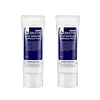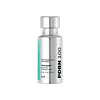What's inside
What's inside
 Key Ingredients
Key Ingredients

 Benefits
Benefits

 Concerns
Concerns

No concerns
 Ingredients Side-by-side
Ingredients Side-by-side

Galactomyces Ferment Filtrate
HumectantWater
Skin ConditioningGlycerin
HumectantGlycereth-26
HumectantSorbitol
HumectantBetaine
HumectantCarbomer
Emulsion StabilisingArginine
MaskingSh-Oligopeptide-1
Skin ConditioningSh-Polypeptide-11
Sh-Oligopeptide-2
Skin ConditioningCopper Tripeptide-1
Skin ConditioningMadecassoside
AntioxidantMadecassic Acid
Skin ConditioningAsiaticoside
AntioxidantAsiatic Acid
Skin ConditioningDextrin
AbsorbentBeta-Glucan
Skin ConditioningXanthan Gum
EmulsifyingPanthenol
Skin ConditioningAllantoin
Skin ConditioningDipotassium Glycyrrhizate
HumectantEthylhexylglycerin
Skin ConditioningPropanediol
SolventChamaecyparis Obtusa Branch/Leaf Extract
Humectant1,2-Hexanediol
Skin ConditioningGalactomyces Ferment Filtrate, Water, Glycerin, Glycereth-26, Sorbitol, Betaine, Carbomer, Arginine, Sh-Oligopeptide-1, Sh-Polypeptide-11, Sh-Oligopeptide-2, Copper Tripeptide-1, Madecassoside, Madecassic Acid, Asiaticoside, Asiatic Acid, Dextrin, Beta-Glucan, Xanthan Gum, Panthenol, Allantoin, Dipotassium Glycyrrhizate, Ethylhexylglycerin, Propanediol, Chamaecyparis Obtusa Branch/Leaf Extract, 1,2-Hexanediol
Water
Skin ConditioningIsopropyl Myristate
EmollientPanax Ginseng Root Extract
EmollientCaprylic/Capric Triglyceride
MaskingCetyl Ethylhexanoate
EmollientGlycerin
HumectantPropanediol
SolventNiacinamide
SmoothingPolyglyceryl-2 Dipolyhydroxystearate
Skin ConditioningPEG-30 Dipolyhydroxystearate
EmulsifyingPolyglyceryl-3 Diisostearate
Emulsifying1,2-Hexanediol
Skin ConditioningTocopherol
AntioxidantHydroxyacetophenone
AntioxidantHelianthus Annuus Seed Oil
EmollientAcrylates/C10-30 Alkyl Acrylate Crosspolymer
Emulsion StabilisingArginine
MaskingAdenosine
Skin ConditioningCeramide NP
Skin ConditioningAdansonia Digitata Seed Oil
EmollientDisodium EDTA
Hydrogenated Lecithin
EmulsifyingAllantoin
Skin ConditioningSqualane
EmollientPanthenol
Skin ConditioningPolyglucuronic Acid
Skin ConditioningCeramide Ns
Skin ConditioningCeramide As
Skin ConditioningCeramide EOP
Skin ConditioningCeramide AP
Skin ConditioningSodium Dna
Skin ConditioningWater, Isopropyl Myristate, Panax Ginseng Root Extract, Caprylic/Capric Triglyceride, Cetyl Ethylhexanoate, Glycerin, Propanediol, Niacinamide, Polyglyceryl-2 Dipolyhydroxystearate, PEG-30 Dipolyhydroxystearate, Polyglyceryl-3 Diisostearate, 1,2-Hexanediol, Tocopherol, Hydroxyacetophenone, Helianthus Annuus Seed Oil, Acrylates/C10-30 Alkyl Acrylate Crosspolymer, Arginine, Adenosine, Ceramide NP, Adansonia Digitata Seed Oil, Disodium EDTA, Hydrogenated Lecithin, Allantoin, Squalane, Panthenol, Polyglucuronic Acid, Ceramide Ns, Ceramide As, Ceramide EOP, Ceramide AP, Sodium Dna
 Reviews
Reviews

Ingredients Explained
These ingredients are found in both products.
Ingredients higher up in an ingredient list are typically present in a larger amount.
1,2-Hexanediol is a synthetic liquid and another multi-functional powerhouse.
It is a:
- Humectant, drawing moisture into the skin
- Emollient, helping to soften skin
- Solvent, dispersing and stabilizing formulas
- Preservative booster, enhancing the antimicrobial activity of other preservatives
Allantoin is a soothing ingredient known for its protective and moisturizingg properties. Because of this, it is often added to products with strong active ingredients.
Studies show higher concentrations of this ingredient can promote wound healing.
Though it can be derived from the comfrey plant, allantoin is produced synthetically for cosmetic products to ensure purity.
Learn more about AllantoinArginine is an amino acid that is important for human development. Your body uses is it to produce hair keratin and skin collagen.
As a cosmetic ingredient, Arginine has antioxidant properties and can also help repair damaged skin. This ingredient is derived either synthetically or from animals.
Arginine isn't fungal acne safe when used in the presence of other lipids (fats, fatty acids, oils, esters, etc). Oils and fats occur naturally within the skin, so take caution when using Arginine if you're prone to fungal acne.
Learn more about ArginineGlycerin is already naturally found in your skin. It helps moisturize and protect your skin.
A study from 2016 found glycerin to be more effective as a humectant than AHAs and hyaluronic acid.
As a humectant, it helps the skin stay hydrated by pulling moisture to your skin. The low molecular weight of glycerin allows it to pull moisture into the deeper layers of your skin.
Hydrated skin improves your skin barrier; Your skin barrier helps protect against irritants and bacteria.
Glycerin has also been found to have antimicrobial and antiviral properties. Due to these properties, glycerin is often used in wound and burn treatments.
In cosmetics, glycerin is usually derived from plants such as soybean or palm. However, it can also be sourced from animals, such as tallow or animal fat.
This ingredient is organic, colorless, odorless, and non-toxic.
Glycerin is the name for this ingredient in American English. British English uses Glycerol/Glycerine.
Learn more about GlycerinPanthenol is a common ingredient that helps hydrate and soothe the skin. It is found naturally in our skin and hair.
There are two forms of panthenol: D and L.
D-panthenol is also known as dexpanthenol. Most cosmetics use dexpanthenol or a mixture of D and L-panthenol.
Panthenol is famous due to its ability to go deeper into the skin's layers. Using this ingredient has numerous pros (and no cons):
Like hyaluronic acid, panthenol is a humectant. Humectants are able to bind and hold large amounts of water to keep skin hydrated.
This ingredient works well for wound healing. It works by increasing tissue in the wound and helps close open wounds.
Once oxidized, panthenol converts to pantothenic acid. Panthothenic acid is found in all living cells.
This ingredient is also referred to as pro-vitamin B5.
Learn more about PanthenolPropanediol is an all-star ingredient. It softens, hydrates, and smooths the skin.
It’s often used to:
Propanediol is not likely to cause sensitivity and considered safe to use. It is derived from corn or petroleum with a clear color and no scent.
Learn more about PropanediolWater. It's the most common cosmetic ingredient of all. You'll usually see it at the top of ingredient lists, meaning that it makes up the largest part of the product.
So why is it so popular? Water most often acts as a solvent - this means that it helps dissolve other ingredients into the formulation.
You'll also recognize water as that liquid we all need to stay alive. If you see this, drink a glass of water. Stay hydrated!
Learn more about Water